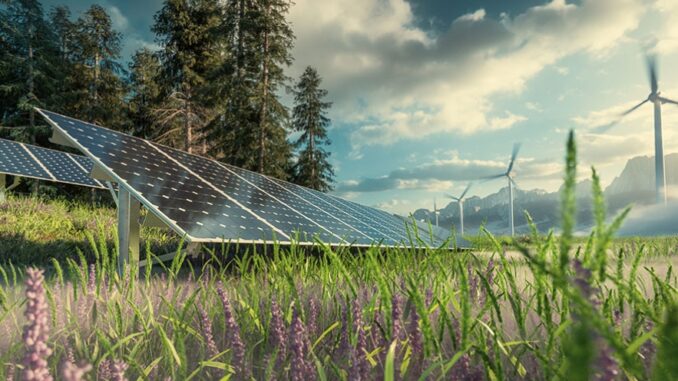
Infrastructure Projects: Funding the construction of renewable energy plants, such as wind farms, solar parks, and hydroelectric dams.
Technology Development: Investing in companies developing new and improved renewable energy technologies, including energy storage solutions.








Financial Instruments
Green Bonds: Bonds specifically earmarked to be used for climate and environmental projects, including renewable energy.
Renewable Energy Funds: Mutual funds or exchange-traded funds (ETFs) that focus on renewable energy companies or projects.
Government and Policy Support
Subsidies and Incentives: Government programs that provide financial support for renewable energy projects, such as tax credits, grants, and rebates.
Public-Private Partnerships: Collaborations between governments and private companies to fund and develop renewable energy infrastructure.
2. Economic Benefits of Investing in Renewable Energy
Job Creation
Employment Opportunities: The renewable energy sector is a significant source of job creation, with roles in manufacturing, installation, maintenance, and research and development.
Economic Growth: Investments in renewable energy contribute to economic development, particularly in regions where renewable resources are abundant.
Cost Savings
Lower Operating Costs: Renewable energy technologies, once installed, typically have lower operating costs compared to fossil fuel plants, as they do not require fuel purchases.
Price Stability: Renewables provide a hedge against volatile fossil fuel prices, leading to more predictable energy costs.
3. Environmental and Social Benefits
Climate Change Mitigation
Reduction in Greenhouse Gas Emissions: Investing in renewable energy helps decrease the carbon footprint and mitigate climate change impacts.
Sustainable Development: Renewable energy projects support sustainable development goals, providing clean and reliable energy while preserving natural resources.
Improved Public Health
Reduced Air Pollution: Investments in renewable energy reduce reliance on fossil fuels, leading to lower emissions of harmful pollutants and better public health outcomes.
Energy Access and Security
Rural Electrification: Renewable energy can bring electricity to remote and underserved areas, improving quality of life and economic opportunities.
Energy Independence: By diversifying energy sources and reducing dependence on imported fuels, renewable energy investments enhance national energy security.
4. Technological Advancements and Innovation
R&D and Innovation
Advancing Technology: Investment in renewable energy drives research and development, leading to technological advancements and increased efficiency.
Energy Storage Solutions: Funding for battery and other storage technologies enhances the reliability and integration of renewable energy into the grid.
Grid Modernization
Smart Grids: Investments in smart grid technology enable better management and distribution of renewable energy, improving grid stability and efficiency.
Microgrids: Localized energy grids that can operate independently or in conjunction with the main grid, enhancing resilience and reliability.
5. Challenges and Risk Mitigation
Initial Capital Costs
High Upfront Costs: Renewable energy projects often require significant initial investment. However, these costs are offset by lower operating expenses over time.
Financing Solutions: Innovative financing mechanisms, such as power purchase agreements (PPAs) and green bonds, can help manage upfront costs.
Policy and Regulatory Risks
Policy Stability: Consistent and supportive government policies are crucial for encouraging investment. Uncertainty in policy can deter investment.
Regulatory Support: Clear and favorable regulations are needed to facilitate the development and integration of renewable energy projects.
Technological and Market Risks
Technological Uncertainty: Rapid technological changes can pose risks, but they also present opportunities for improvement and cost reductions.
Market Fluctuations: Market demand for renewable energy can be influenced by economic conditions and competition from other energy sources.
6. Global Trends and Examples
Europe
Leading the Way: Countries like Germany, Denmark, and Spain have made significant investments in renewable energy, achieving high levels of renewable penetration in their energy mixes.
Policy Support: Strong government policies and incentives have been crucial in driving investment.
United States
State-Level Initiatives: States such as California and Texas have invested heavily in renewable energy, supported by state-level mandates and incentives.
Corporate Investment: Many large corporations are investing in renewable energy to meet sustainability goals and reduce energy costs.
Asia
Rapid Expansion: China and India are rapidly expanding their renewable energy capacity, driven by government targets and economic growth.
Technological Leadership: China, in particular, is becoming a global leader in renewable energy technology manufacturing.
Conclusion
Investing in renewable energy is essential for achieving a sustainable, low-carbon future. It offers numerous economic, environmental, and social benefits, including job creation, cost savings, climate change mitigation, and improved public health. Despite the challenges, strategic investments, supportive policies, and technological advancements are driving the transition to a renewable energy future, making it a compelling and necessary endeavor for governments, businesses, and investors worldwide.

Leave a Reply